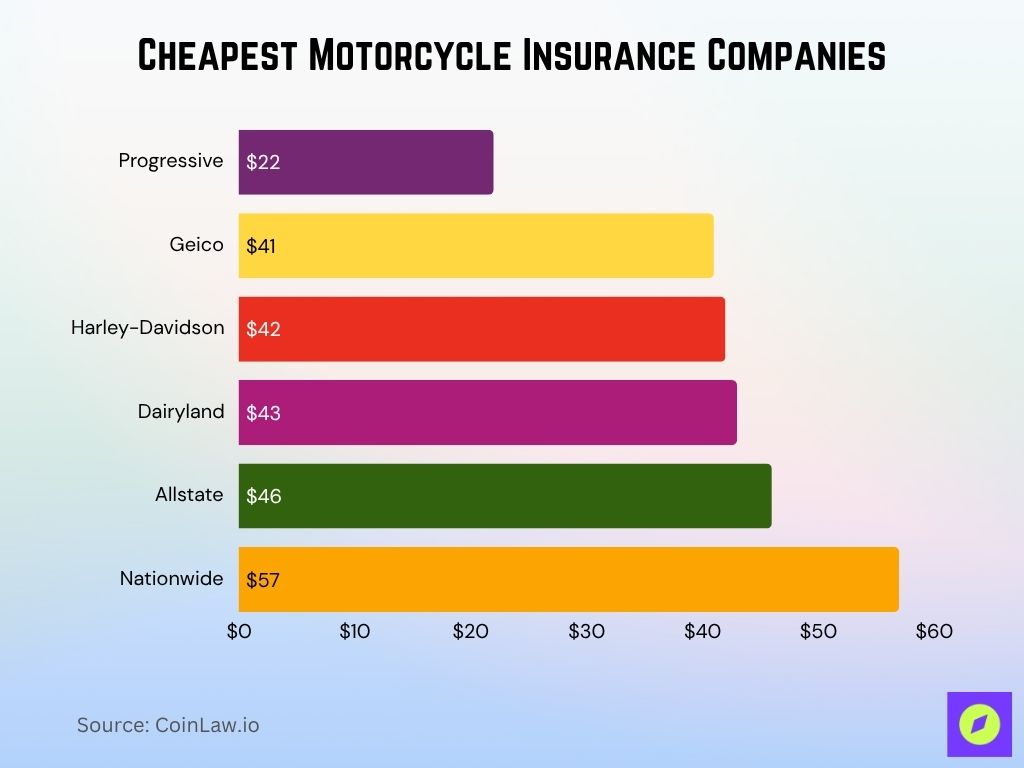Picture this: You’ve just bought the motorcycle of your dreams, ready to feel the wind in your face and the freedom of the open road. But before the thrill, there’s a crucial question to answer: how will you protect your investment? With motorcycles becoming increasingly popular in the U.S. and globally, motorcycle insurance has evolved from a straightforward policy into a nuanced and critical sector. Whether you’re a seasoned rider or a new enthusiast, understanding motorcycle insurance trends for 2025 can help you make informed choices while maximizing coverage and minimizing costs.
Key Takeaways
- 1U.S. motorcycle insurance premiums rose by 4.2% in 2025, driven by inflation in repair and parts costs.
- 2Roughly 42% of motorcycle insurance claims in 2025 were for collision coverage, reflecting ongoing traffic and accident growth.
- 3Online insurance sales channels now account for 29% of all policies sold globally as digital adoption continues.
- 4Riders under 25 pay 31% higher premiums than older riders due to elevated risk profiles and incident rates.
- 5Electric motorcycle insurance policies surged by 24% in 2025 as EV adoption accelerated across urban areas.
Cheapest Motorcycle Insurance Companies
- Progressive offers the lowest monthly rate at just $22, making it the most affordable option for motorcycle insurance in Missouri.
- Geico provides coverage at $41 per month, slightly below the state average of $42.
- Harley-Davidson Insurance matches the state average monthly premium of $42, offering balanced cost and brand-specific coverage.
- Dairyland charges a bit more at $43 per month, only $1 above average, making it a moderately priced alternative.
- Allstate comes in higher with a monthly cost of $46, which is $4 more than the average.
- Nationwide is the most expensive, with a monthly premium of $57, which is $15 above the average.

Motorcycle Insurance Market Dynamics
- The U.S. motorcycle insurance market size is projected to exceed $2.2 billion in 2025, fueled by strong sales and tighter insurance mandates.
- Urban premium growth climbed to 5.6% annually in 2025 as motorcycle use intensifies in congested cities.
- Motorcycle thefts topped 52,000 in 2025, driving up premiums in states with high reported incidents.
- Comprehensive coverage demand rose by 9.3% in 2025 as more riders opt for broader protection.
- Short-term insurance policies saw a 13.5% increase in demand among seasonal and part-time riders in 2025.
- Usage-based insurance with telematics made up 18% of new policies in 2025 as insurers embrace data-driven pricing.
- Claims for medical expenses now constitute 35% of all claims due to rising healthcare costs associated with motorcycle accidents.
Motorcycle Insurance Market Segmentation
- Urban riders in 2025 pay 22–27% higher premiums than rural riders due to increased traffic density and accident exposure.
- Sport motorcycle insurance rates are 19% higher in 2025 than standard bikes because of greater speed risks and claim history.
- Riders aged 35–50 in 2025 continue to enjoy the lowest premium rates thanks to favorable insurer risk assessments.
- New riders with less than 1 year of experience pay on average 27% more in premiums than those with over 5 years of riding history.
- 28% of motorcycle policyholders now bundle with home or auto insurance in 2025, earning up to 16% in savings.
- Male riders in 2025 face 11% higher premiums than females due to statistically higher accident and claim rates.
- Seasonal policies are chosen by 32% of riders in colder climates in 2025, helping cut annual insurance costs significantly.
Motorcycle Insurance Costs Based on Storage Location
- Where you store your motorcycle directly affects your insurance premium; the safer the location, the cheaper the cost.
- For the Honda PCX, annual insurance costs range from £405 (in a locked garage) to £618 (when stored on the road).
- The Yamaha Tracer GT sees premiums from £459 (locked garage) up to £705 (on the road).
- The BMW R1200 GS is the most expensive model to insure, with rates rising from £713 (locked garage) to £1,141 (on the road).
- On average, storing your bike in a locked garage can save you over £400 per year compared to leaving it on the road.
- Driveway storage offers a middle ground in pricing but still comes with a higher cost than garage storage.

Insurance Type Insight
- Liability coverage remains the most common insurance type, with 85% of U.S. motorcyclists opting for this minimum requirement, primarily to comply with state laws.
- Comprehensive and collision coverage has gained traction, with 40% of policyholders now opting for these to cover theft and damage beyond accidents.
- Policies with uninsured/underinsured motorist coverage account for 30% of all motorcycle policies due to increased awareness of uninsured riders on the road.
- Medical payments (MedPay) insurance has seen a 12% increase in adoption, covering medical expenses regardless of fault in an accident.
- Custom parts and equipment coverage is essential for 20% of riders, especially those with modified or vintage bikes, as it covers non-standard parts in case of damage.
- Roadside assistance add-ons have surged by 15% year-over-year, with riders seeking support for breakdowns, particularly in remote areas.
- Gap insurance, covering the difference between a bike’s value and outstanding loan balance, is chosen by 10% of financed motorcycle buyers to avoid financial loss if their bike is totaled.
Competitive Landscape
- 62% of riders in 2025 cite affordability as their top reason for selecting a policy provider.
- 37% of policyholders are now willing to pay slightly higher premiums for superior customer service and faster claims support.
- 47% of riders aged 18–30 in 2025 prefer insurers offering user-friendly apps and digital features.
- Usage-based insurance (UBI) continues to expand, now included in 20% of new policies in 2025 as telematics gains adoption.
- Regional insurers focusing on electric motorcycles have grown to capture 8.5% of the market in 2025 by offering tailored coverage.
- Bundled discounts are used by 32% of riders in 2025, favoring insurers who package motorcycle, auto, and home policies.
Motorcycle Insurance Costs for 21-Year-Olds by State
- Pennsylvania and New York are tied for the lowest average monthly rate at $46, making them the most affordable states for young riders.
- The national average cost for 21-year-olds is $53 per month for a full-coverage policy.
- Georgia riders pay slightly more than average, with a monthly premium of $55.
- Texas follows closely at $56 per month, placing it among the higher-cost states for this age group.
- California is the most expensive, with a monthly average of $60, which is $14 higher than Pennsylvania and New York.

Impact of Technological Advancements
- Telematics-enabled policies now account for 22% of motorcycle insurance plans in 2025, reflecting strong growth in usage-based pricing.
- AI-driven claims processing has cut average handling time by 33% in 2025, significantly boosting customer satisfaction.
- Mobile apps with GPS and safety features are offered by 84% of major insurers in 2025, becoming a standard for riders.
- Smart helmets and wearables are linked to premium discounts of 6–11% in 2025 for tech-equipped, safety-conscious riders.
- Blockchain technology is in active pilot programs at five major insurers in 2025 for secure claims verification and sharing.
- Predictive analytics are now used in 18% of new motorcycle policies in 2025 to refine risk scoring and combat fraud.
- Electric motorcycle owners can access insurance discounts of up to 12% in 2025 with EV-specific products and incentives.
Geographical Distribution of Motorcycle Registration
- California and Florida lead the U.S. in motorcycle registrations, together accounting for nearly 30% of all motorcycles on American roads.
- Texas, Pennsylvania, and Ohio also have high motorcycle ownership, collectively covering about 15% of the national total.
- Rural regions show higher per capita motorcycle ownership, where motorcycles often serve as primary transportation due to limited public transit.
- Urban registrations in cities like Los Angeles, New York, and Chicago are high, yet these areas face significantly higher premiums due to traffic and theft risks.
- Pacific Northwest states report increasing registrations, driven by outdoor tourism and rising interest in adventure motorcycles.
- Southern states like Georgia and North Carolina see seasonal variations, with 15-20% more registrations during warmer months.
- Midwestern states have lower overall registrations, but motorcycles are used extensively for leisure riding, especially in states like Michigan and Ohio.
Global Motor Insurance Market Growth Outlook
- The global motor insurance market is expected to grow to $960.69 billion in 2025.
- A compound annual growth rate (CAGR) of 9.7% is projected through the forecast period.
- By 2029, the market size is forecasted to reach $1,390.63 billion, showing substantial long-term expansion.
This steady growth reflects increasing demand, vehicle ownership, and evolving insurance technologies worldwide.

Emerging Trends in Electric Motorcycle Insurance
- Electric motorcycle policies have grown by 25% in the last year, spurred by a rise in eco-conscious riders and EV incentives.
- Policy discounts for electric motorcycles average around 10%, as insurers support green initiatives and lower maintenance costs.
- Battery replacement coverage is now offered by 25% of insurers, covering high-cost battery replacements that are unique to EVs.
- Charging station locator tools are becoming a feature in insurance apps, helping EV riders locate convenient charging stations.
- Specialized EV roadside assistance is gaining traction, with services including emergency charging, provided by 10% of major insurers.
- Electric motorcycles are increasingly popular among urban riders, with 40% of electric bike registrations concentrated in major cities.
- Environmentally-focused marketing is appealing to millennials and Gen Z, with 55% of new EV policyholders in these age groups.
Factors Influencing Motorcycle Insurance Rates
- Age of the Rider: Younger riders, particularly those under 25 years old, face premiums up to 30% higher due to their higher risk profile.
- Experience Level: Riders with less than 2 years of experience typically pay 20-25% more for insurance, as they’re considered at a higher risk of accidents.
- Type of Motorcycle: Sport and high-performance bikes come with insurance rates 15-20% higher than standard or cruiser motorcycles due to their speed and accident rates.
- Location: Urban areas often carry 25% higher premiums than rural locations due to higher traffic density, accident likelihood, and theft rates.
- Annual Mileage: Riders with higher annual mileage, especially those exceeding 10,000 miles per year, tend to pay higher premiums as more time on the road increases accident risk.
- Riding Record: A history of traffic violations or accidents can increase premiums by up to 50%, depending on the severity and recency of infractions.
- Motorcycle Modifications: Custom modifications can raise premiums by 10-15% to account for the increased repair and replacement costs associated with non-standard parts.
- Safety Equipment: Riders who use advanced safety gear, like anti-lock braking systems (ABS), often qualify for 5-10% discounts as insurers recognize these features can reduce accident severity.
- Coverage Limits: Higher coverage limits naturally increase premiums. For instance, opting for $500,000 liability coverage versus a $100,000 limit can raise premiums by 15-20%.
- Multi-Policy Discounts: Bundling motorcycle insurance with other policies, like home or auto, can save policyholders 10-15% on their overall insurance costs.
Recent Developments
- Rising Premiums: Motorcycle insurance premiums have increased by an average of 5% in 2023, largely due to inflationary pressures, higher repair costs, and increased claim frequency.
- Growth in Telematics: The adoption of telematics in motorcycle insurance is growing, with 10% of insurers now offering usage-based discounts to riders who opt into tracking mileage and riding behavior.
- Electric Motorcycle Policies: Policies specifically tailored for electric motorcycles saw a 30% growth last year, with insurers adapting coverage options for battery replacement and charging assistance.
- Enhanced Digital Claims Processing: Many insurers are now using AI-driven claims systems, reducing claim processing times by 30% on average, which significantly improves customer satisfaction.
- Increased Focus on Theft Coverage: Motorcycle theft has surged, prompting 15% more riders to add comprehensive coverage to protect against theft, especially in high-risk urban areas.
- Policy Add-Ons for Custom Bikes: Due to growing interest in custom motorcycles, insurers now offer specialized add-ons for modifications, which cover non-standard parts and custom equipment.
- Discounts for Safety Courses: Many insurers have expanded discounts for riders who complete advanced safety courses, offering up to 10% off for certified training.
- New Insurer Entry: Smaller, regional insurers have entered the market, offering competitive rates and flexible coverage options, particularly in the electric and high-performance motorcycle segments.
- Seasonal Insurance Packages: With increased demand for seasonal riding coverage, 20% of insurers now offer packages allowing riders to adjust their coverage during off-peak months, reducing costs for seasonal riders.
- Expansion of Mobile App Features: Mobile apps now provide more than basic account management, with GPS-enabled emergency services and roadside assistance tools growing in popularity among major insurers.
Conclusion
As the motorcycle insurance industry evolves in 2025, it is clear that traditional policies are adapting to new dynamics, whether it’s technological innovation, regional shifts, or the rise of electric motorcycles. These changes present a landscape that’s not only more diverse but increasingly accessible to a range of riders, from urban commuters to eco-conscious travelers. Whether you’re insuring a classic cruiser or the latest electric model, staying informed on these trends can help you find the right coverage for both peace of mind and financial security on every ride.
Hover or focus to see the definition of the term.


























































